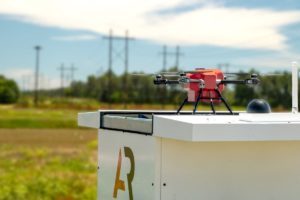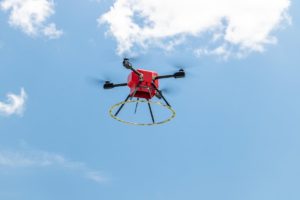

By Jim Magill
One year after the company he leads became the first drone system manufacturer to receive FAA approval to operate an autonomous drone system without human oversight, Reese Mozer, CEO of American Robotics, said automation will be the key driver of growth for the commercial drone industry over the next decade.
“The underlying theme is going to be autonomy. It really unlocks so much more than what we’ve been able to do in the past,” he said.
The use of autonomous drones across a wide spectrum of commercial applications will enable users not only to increase the frequency of drone flights, but also to increase the ways in which the data collected can be used, Mozer said.
“In most cases, we’re just scratching the surface on that, so I think that next 10 years is going to be substantially different from the last 10, particularly in the commercial sector. I think that’s going to be where most of the growth is going to be,” he said.
In January, 2021, the Federal Aviation Administration (FAA) gave its approval to the company’s Scout System to operate automated drones without human pilots or observers on-site. The Scout System features advanced acoustic detect-and-avoid (DAA) technology that enables its drones to maintain a safe distance from other aircraft at all times.
“By developing a layered, redundant system of safety that includes proprietary technical and operational risk mitigations, American Robotics has proven that its drone-based aerial intelligence platform operates safely in the National Airspace System (NAS), even when it conducts flights beyond the visual line of sight (BVLOS) of the operator,” the company said in a press release at the time of the approval.

Over the next several years, the approval is expected to pave the way for increased use of drone technology in a wide variety of sectors, including: agriculture and infrastructure inspection in industries ranging from oil and gas, mining and railroads, to solar farms and other forms of renewable energy.
“It’s arguably the most important approval to date in the commercial drone space, because without that type of approval automated drones can’t function,” Mozer said. He estimated that in the future automated autonomous drones will be required in 90% of all commercial drone activity.
“The way to think about it is: anything that requires frequent inspection over the same area, likely requires an automated system like ours to be practical,” he said. “There is a very sharp line between commercial drones being practical or not being practical and that’s driven by this approval and all the technology that went into it.”
Founded in 2016, American Robotics has been laser-focused on developing and winning approval for an autonomous drone system able to operate without the need of expensive human labor. The research and development process involved complex engineering challenges and frequent and extensive engagement with federal regulators, Mozer said.
He called the FAA approval process “very intensive and painful and expensive,” but said American Robotics approached the process from a technological perspective as opposed to a lobbying perspective.
“We had pretty much put all of our eggs in this basket and really took a strong approach that this is the minimum bar we need to reach to make this business work,” he said. “We had to develop and prove out a system that meets a certain level of safety and do that with technology.”
From the time that American Robotics formally submitted its application for approval of an autonomous drone system to final approval “took two years of working with the FAA on a weekly basis, if not multiple times a week,” Mozer said.
Lance Ruppert, director of agronomy marketing and technology at Growmark, Inc., a leading U.S. grower cooperative, said the ability to employ autonomous drone systems would speed the adoption of drone technology the agricultural sector.
“The FAA’s decision to allow autonomous drone flights will allow the furtherment of advanced crop scouting and intelligence while helping to lessen the already strained human resource issue in agriculture,” he said. “The ability for a centralized manager to develop a flight plan for multiple drones and then consume the information seamlessly allows for broader scalability of drones and potentially increases their value to farmers.”
Read more about American Robotics’ automated solution for agriculture, FAA Approval, on the Resurgence of U.S. Drone Companies, acquisition by Ondas Holdings.
Miriam McNabb is the Editor-in-Chief of DRONELIFE and CEO of JobForDrones, a professional drone services marketplace, and a fascinated observer of the emerging drone industry and the regulatory environment for drones. Miriam has penned over 3,000 articles focused on the commercial drone space and is an international speaker and recognized figure in the industry. Miriam has a degree from the University of Chicago and over 20 years of experience in high tech sales and marketing for new technologies.
For drone industry consulting or writing, Email Miriam.
TWITTER:@spaldingbarker
Subscribe to DroneLife here.